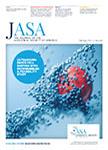版权所有:内蒙古大学图书馆 技术提供:维普资讯• 智图
内蒙古自治区呼和浩特市赛罕区大学西街235号 邮编: 010021

作者机构:Univ Paisley Sch Informat & Commun Technol Elect Engn & Phys Div Paisley PA1 2BE Renfrew Scotland
出 版 物:《JOURNAL OF THE ACOUSTICAL SOCIETY OF AMERICA》 (美国声学会志)
年 卷 期:2001年第110卷第6期
页 面:3232-3242页
核心收录:
学科分类:1002[医学-临床医学] 07[理学] 082403[工学-水声工程] 08[工学] 070206[理学-声学] 0824[工学-船舶与海洋工程] 0702[理学-物理学]
主 题:broadband signal Scheme Noise subband Subbands intelligibility Speech Intelligibility Speech noise signal Least mean square algorithm Signaling In Band Self tuning
摘 要:This article reports on the performance of an adaptive subband noise cancellation scheme, which performs binaural preprocessing of speech signals for a hearing-aid application. The multi-microphone subband adaptive (MMSBA) signal processing scheme uses the least mean squares (LMS) algorithm in frequency-limited subbands. The use of subbands enables a diverse processing mechanism to be employed, splitting the two-channel wide-band signal into smaller frequency-limited subbands, which can be processed according to their individual signal characteristics. The frequency delimiting used a linear- or cochlear-spaced subband distribution. The effect of the processing scheme on speech intelligibility was assessed in a trial involving 15 hearing-impaired volunteers with moderate sensorineural hearing loss. The acoustic material consisted of speech and speech-shaped noise signals, generated using simulated and real-room acoustic environments, at signal-to-noise ratios (SNRs) in the range -6 to +3 dB. The results show that the MMSBA scheme delivered average speech intelligibility improvements of 11.5%, with a maximum of 37.25%, in noisy reverberant conditions. There was no significant reduction in mean speech intelligibility due to processing, in any of the test conditions. (C) 2001 Acoustical Society of America.